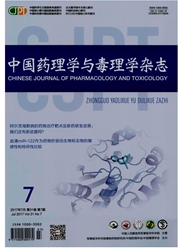

 中文摘要:
中文摘要:
目的研究麦冬皂苷D′对大鼠心肌细胞H9c2的细胞毒性作用,初步探讨其作用机制,为寻找其临床安全使用剂量提供依据。方法麦冬皂苷D′0.1,1,5,10,20,25和50μmo·L(-1)作用于H9c2细胞24 h。MTS法检测细胞存活率及其IC_(50);荧光显微镜观察细胞形态变化;高内涵免疫荧光筛选检测细胞核数目变化;流式细胞仪检测其活性氧生成、线粒体膜电位和细胞凋亡率。结果麦冬皂苷D′0.1,1,5,10,20,25和50μmol·L(-1)作用于H9c2细胞24 h后,细胞存活率分别为108.9%,106.3%,91.9%,61.0%,24.8%,24.7%和24.2%,IC_(50)为9.9μmol·L(-1);荧光显微镜检测显示细胞皱缩;高内涵免疫荧光检测显示细胞核数目减少(P〈0.05)。流式细胞术检测显示,麦冬皂苷D′0.1,1,5和10μmol·L(-1)显著升高活性氧生成量(P〈0.05),降低线粒体膜电位(P〈0.05),升高细胞凋亡率(P〈0.05)。结论麦冬皂苷D′对H9c2心肌细胞有明显的细胞毒性作用,该作用可能与其激活细胞凋亡通路有关。
 英文摘要:
英文摘要:
OBJECTIVE To study the cardiotoxicity of ophiopogonin D(OPD) for rat H9c2 cardio- rnyocytes. METHODS H9c2 cells were exposed to OPD' 0.1, 1, 5, 10, 20, 25 and 50 pmol.L-1 for 24 h. Cell viability was examined by MTS assay, and the morphological changes in H9c2 cells were quanti- fied. The cell nucleus injury was examined by high content immune fluorescence screening and the morphological changes were observed under a fluorescence microscope. After treatment with OPD' 0.1, 1, 5 and 10μmol. L-1 for 24 h, the effect on reactive oxygen species (ROS), mitochondrial mem- brane potential(MMP) and apoptosis was detected by flow cytometry. RESULTS The viability was sig- nificantly reduced following exposure to OPD' 0.1, 1, 5, 10, 20, 25 and 50μmol- L-1 (P〈0.05, P〈0.01). The IC50 value was 9.9 μmol. L-1 and cell shrinkage and apoptosis occurred. The levels of ROS and apoptosis rate of H9c2 cells were significantly increased after exposure to OPD' 0.1, 1, 5 and 10 pmol. L-1 for 24 h (P〈0.05,/:)〈0.01) and MMP markedly declined (P〈0.05, P〈0.01). CONCLUSION OPD' has significent cytotoxicity on H9c2 cells. It may be related to inducing apopotsis pathways.
 同期刊论文项目
同期刊论文项目
 同项目期刊论文
同项目期刊论文
 期刊信息
期刊信息
